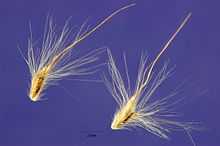Bothriochloa saccharoides
From Wikipedia, the free encyclopedia
| Bothriochloa saccharoides | |
|---|---|
 | |
| seeds | |
| Conservation status | |
| Scientific classification | |
| Kingdom: | Plantae |
| (unranked): | Angiosperms |
| (unranked): | Monocots |
| (unranked): | Commelinids |
| Order: | Poales |
| Family: | Poaceae |
| Genus: | Bothriochloa |
| Species: | B. saccharoides |
| Binomial name | |
| Bothriochloa saccharoides (Sw.) Rydb. | |
Bothriochloa saccharoides is a species of grass known by the common name silver bluestem. It is native to the Americas, including Mexico, the Caribbean, and parts of Central and South America.[1]
This perennial bunchgrass grows to 2 to 3 feet in height. The leaves reach 8 inches long. The stems are often purplish toward the base. The inflorescence is white and hairy. The plant produces many seeds.[2]
This species is used for grazing cattle, especially in the spring before the inflorescences form. Goats eat the seed heads. The grass can be added to a hay mix.[2]
References
- ↑ Bothriochloa saccharoides. Germplasm Resources Information Network.
- ↑ 2.0 2.1 Bothriochloa saccharoides. USDA NRCS Plant Fact Sheet.
External links
| Wikimedia Commons has media related to Bothriochloa saccharoides. |
This article is issued from Wikipedia. The text is available under the Creative Commons Attribution/Share Alike; additional terms may apply for the media files.
